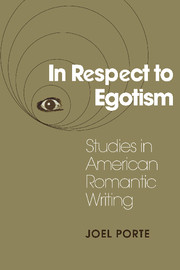Book contents
- Frontmatter
- Contents
- Preface
- Acknowledgments
- In Respect to Egotism
- Introduction: Writing, Reading, Romanticism
- 1 “Where … Is This Singular Career to Terminate?”: Bewildered Pilgrims in Early American Fiction
- 2 “Where There Is No Vision, the People Perish.…”: Prophets and Pariahs in the Forest of the New World
- 3 Poe: Romantic Center, Critical Margin
- 4 Emerson: Experiments in Self-Creation
- 5 Hawthorne: “The Obscurest Man of Letters in America”
- 6 Thoreau's Self-Perpetuating Artifacts
- 7 Melville: Romantic Cock-and-Bull; or, The Great Art of Telling the Truth
- 8 Douglass and Stowe: Scriptures of the Redeemed Self
- 9 Whitman: “Take Me as I Am or Not at All.…”
- Interchapter: Walt and Emily
- 10 Dickinson's “Celestial Vail”: Snowbound in Self-Consciousness
- Notes
- Index
- CAMBRIDGE STUDIES IN AMERICAN LITERATURE AND CULTURE
5 - Hawthorne: “The Obscurest Man of Letters in America”
Published online by Cambridge University Press: 24 March 2010
- Frontmatter
- Contents
- Preface
- Acknowledgments
- In Respect to Egotism
- Introduction: Writing, Reading, Romanticism
- 1 “Where … Is This Singular Career to Terminate?”: Bewildered Pilgrims in Early American Fiction
- 2 “Where There Is No Vision, the People Perish.…”: Prophets and Pariahs in the Forest of the New World
- 3 Poe: Romantic Center, Critical Margin
- 4 Emerson: Experiments in Self-Creation
- 5 Hawthorne: “The Obscurest Man of Letters in America”
- 6 Thoreau's Self-Perpetuating Artifacts
- 7 Melville: Romantic Cock-and-Bull; or, The Great Art of Telling the Truth
- 8 Douglass and Stowe: Scriptures of the Redeemed Self
- 9 Whitman: “Take Me as I Am or Not at All.…”
- Interchapter: Walt and Emily
- 10 Dickinson's “Celestial Vail”: Snowbound in Self-Consciousness
- Notes
- Index
- CAMBRIDGE STUDIES IN AMERICAN LITERATURE AND CULTURE
Summary
On May 24, 1864, Emerson set down in his journal an account of Hawthorne's funeral, held the previous day in Concord, and reflected at large on the perplexing character of this reticent friend whom he hadv never really gotten to know. Emerson remembered a fine September day some twenty years earlier, when he and Hawthorne had set out on a long walk, “in excellent spirits,” and conversed easily, “for we were both old collectors who had never had opportunity before to show each other our cabinets”; however, his dominant recollection was not one of such genial and free interchange of confidence. Hawthorne's life and death, Emerson opined, were endured in a “painful solitude” that was not easily penetrated, even by a sympathetic friend. Emerson found “unwillingness and caprice” where he looked for “unreserved intercourse,” and one odd little detail of the ceremony that he notes – “the corpse was unwillingly shown” – seems intended to serve as an emblem of Hawthorne's unconquerable reserve. The day was “a pomp of sunshine” but Hawthorne remained in the shade - to which, indeed, in a larger sense, the preacher noted, he “had done more justice than any other.”
Emerson's inability to read his friend's character clearly may not have been owing simply to Hawthorne's self-concealing nature, however, but rather to the Transcendentalist's impatience with Hawthorne's fiction. For Hawthorne had noted explicitly in the preface to The Snow-Image, and Other Twice-Told Tales that the direct confessions of a romancer were not to be trusted: “[T]hese things hide the man instead of displaying him.”
- Type
- Chapter
- Information
- In Respect to EgotismStudies in American Romantic Writing, pp. 124 - 163Publisher: Cambridge University PressPrint publication year: 1991

